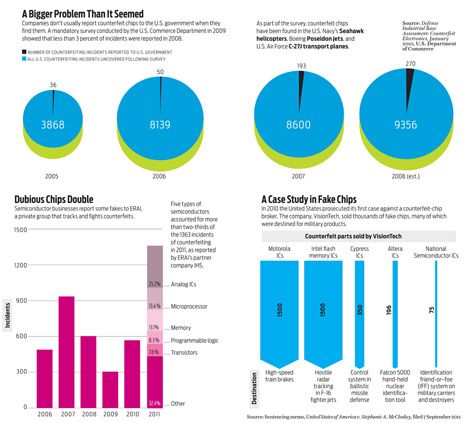Counterfeit Chips on the Rise
As more firms report finding phony chips, the danger they pose becomes clearer
Making semiconductors is a big business—and, so it seems, is counterfeiting them. Just how big is becoming clearer than ever, thanks in part to the candor of the U.S. military, and it will become even clearer as new laws in the United States come into effect later this year.
In 2011, over 1300 counterfeit incidents were reported from around the world to Electronic Resellers Association International (ERAI), a private company that tracks counterfeit electronics for the industry. That’s more than double the number reported in 2010 and 2008, and quadruple the number reported in 2009. ERAI’s partner company, IHS, reported a slightly higher figure for 2011 by including data from the Government-Industry Data Exchange Program, a not-for-profit organization that, among other things, tracks counterfeits and component failures in the United States and Canada.
The fear is that these counterfeits—including used and relabeled commercial gear or components falsely labeled as military grade—will fail more quickly than the parts they’re standing in for. And because semiconductors are an integral part of everything from cellphones to nuclear reactor controls, the failure of a counterfeit chip in the wrong place could have deadly consequences.
“That’s what we’re all afraid of, ” says Jack Stradley, an expert on the U.S. government’s semiconductor supply chain.
The new legislation, the National Defense Authorization Act for Fiscal Year 2012 [PDF], aims to fight counterfeiting by requiring government contractors to track and report counterfeits and to be held accountable for replacement costs.
Until now, companies rarely reported fraudulent chips, says Lawrence Hurst, product fraud prevention manager at Intel. “We haven’t been doing that,” Hurst says. “In fact, most of the industry hasn’t.” In the past there was simply no financial reason to do so, he says. But with a new legal responsibility, Intel is now in the process of creating a database of counterfeit parts it encounters.
The U.S. law is in response to a 2010 U.S. Government Accountability Office report on counterfeits in the military and a 2011 congressional hearing on the dangers of counterfeit electronics. A report introduced in the hearing based on a mandatory survey of producers, dealers, and military contractors, estimates that 9356 fake parts were found in 2008 alone.
Those same counterfeits are sold internationally. Both the Japanese Ministry of Defense and the U.S. Navy bought electromagnetic interference filters from Raytheon electronics, later found to contain counterfeit versions of Fairchild semiconductors. The United Kingdom subsidiary of military contractor General Dynamics also bought counterfeit semiconductors, though it discovered the fraud before including the components in its products, according to the 2010–2011 annual report by the U.K.’s IP Crime Group [PDF, 3/12 MB].
The few prosecuted cases of counterfeit goods distribution show that it’s easy to sneak products into the increasingly complicated supply chain. Between its point of manufacture and its use in an action-ready missile, a semiconductor is often bought and resold many times. Overworked purchasers rely on brokers, who in turn buy from relatively anonymous online forums. In theory, chips are tested at multiple points in the supply chain, but shady companies have lied about tests, authenticity, and origins. The majority of counterfeit chips can be traced to China, but the primary fault lies in the industry’s purchasing practices, Stradley says.
Stradley believes that the new law won’t do enough to force reform of the semiconductor supply chain. It may take a fatal disaster to do that. “It’s always that way,” says Stradley. “That’s part of the problem—we haven’t had any serious accidents we can point to.”
